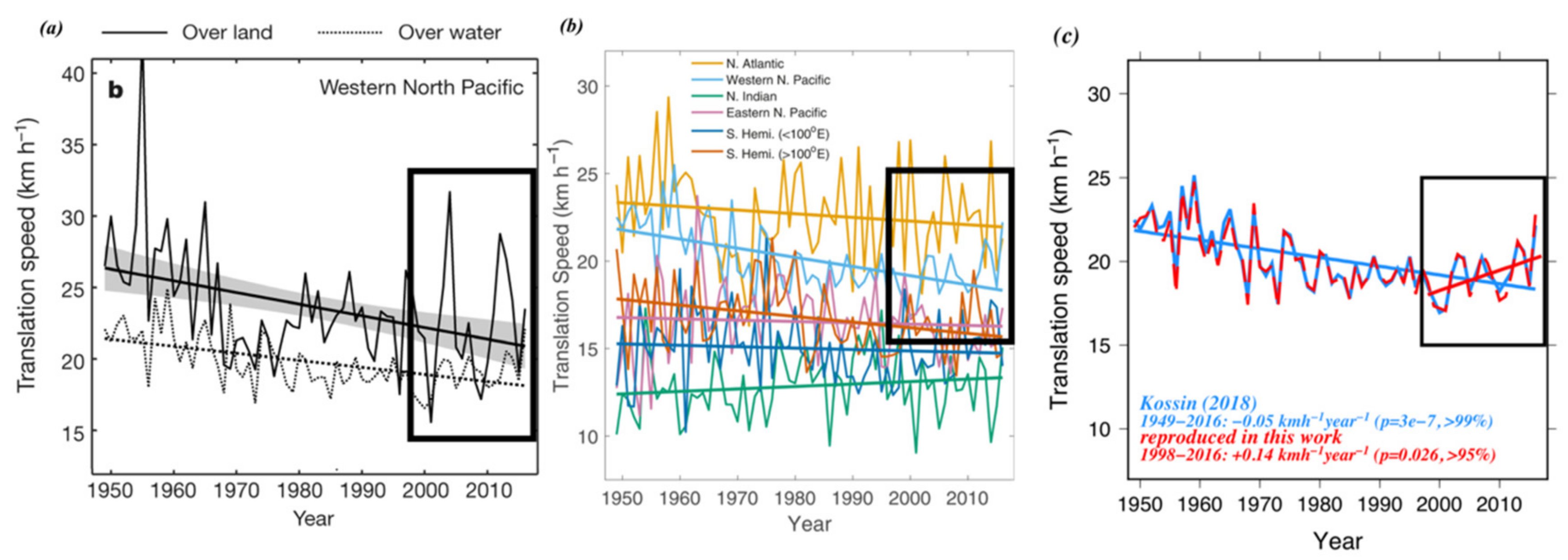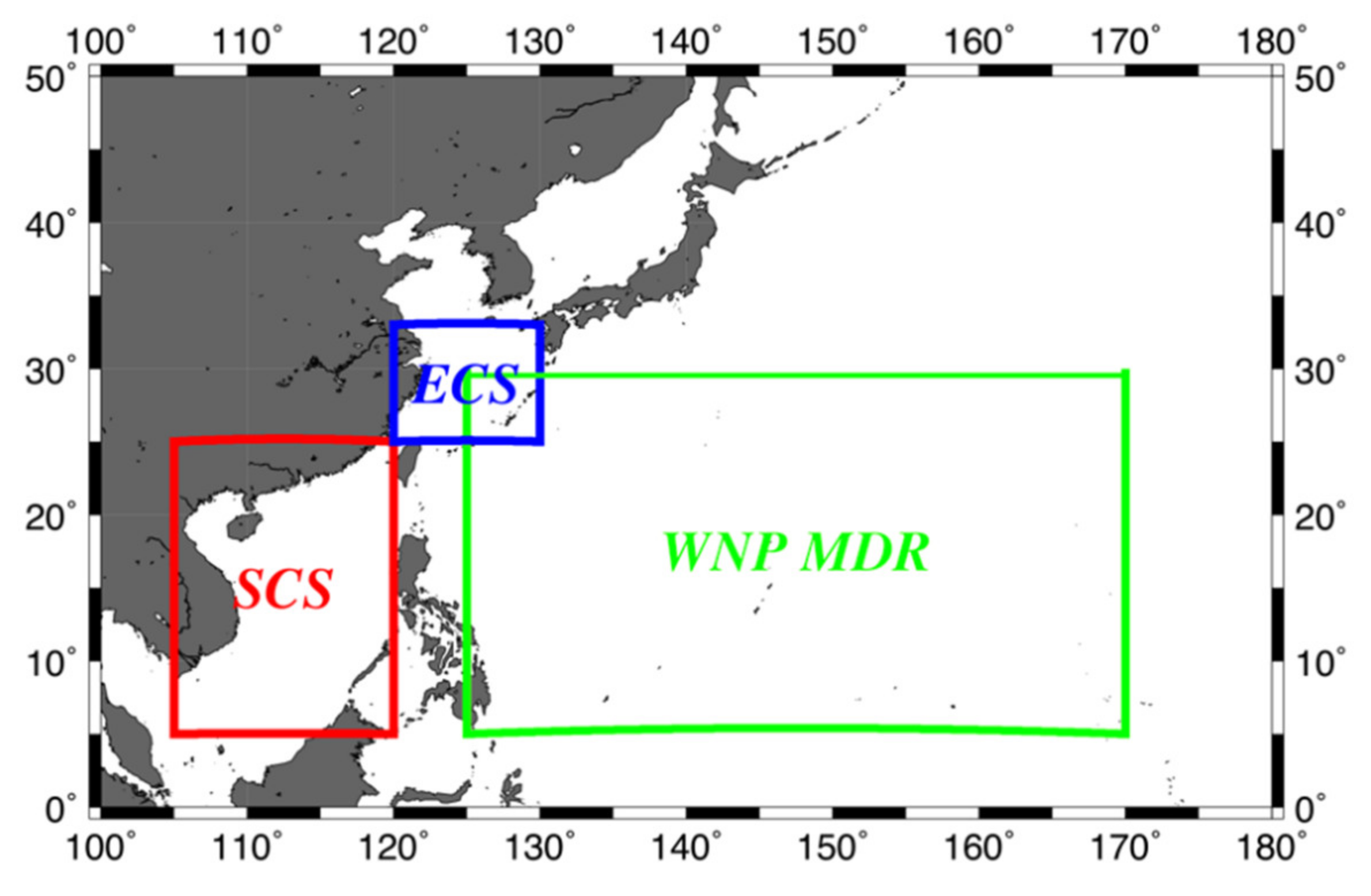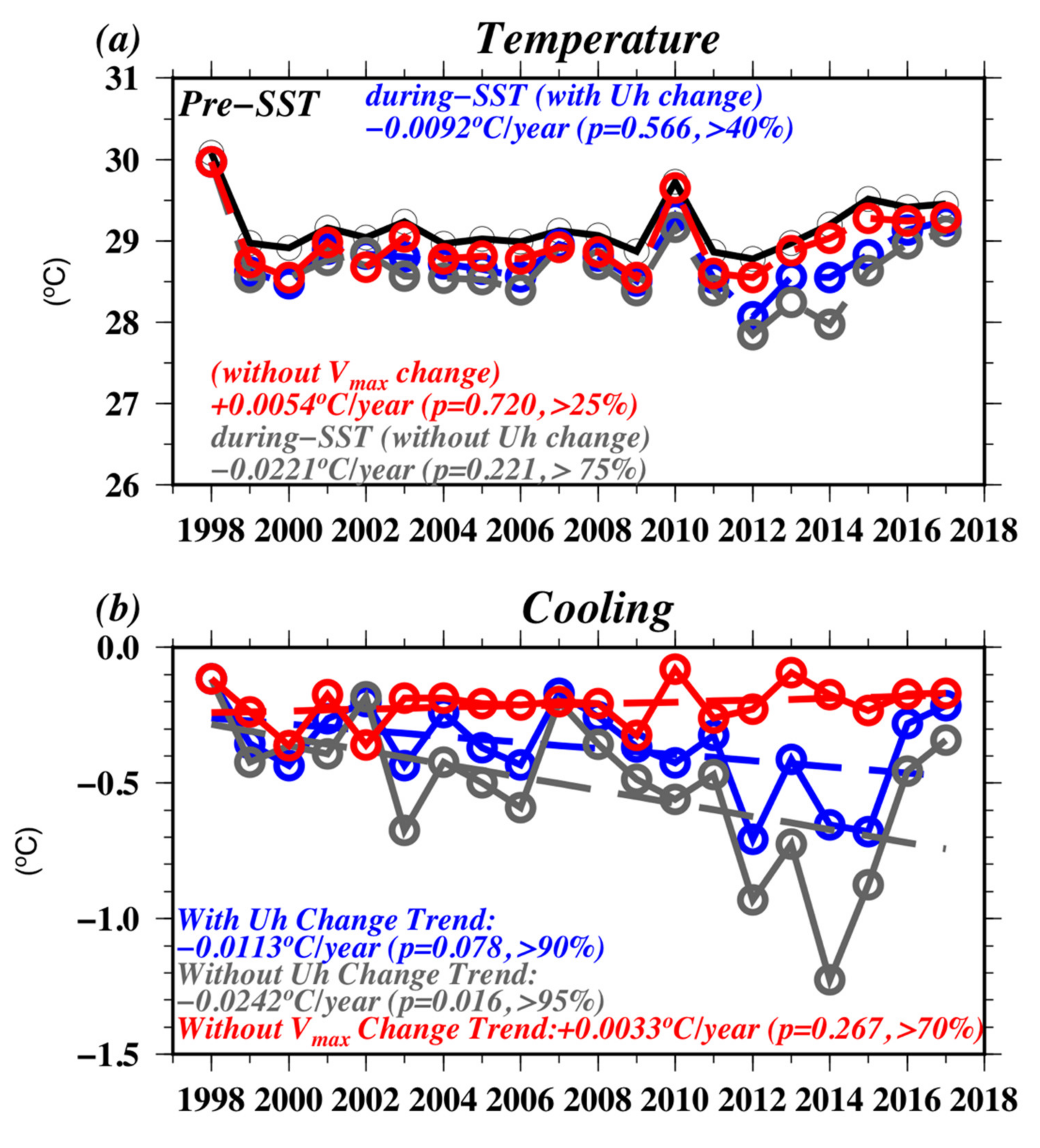The Association of Typhoon Intensity Increase with Translation Speed Increase in the South China Sea
Abstract
1. Introduction
2. Data and Methods
3. Results
3.1. Comparison Between Uh in the WNP, ECS, and SCS
3.2. Observations in the SCS: TC Intensity Change and Pre-TC Ocean Conditions
3.3. Numerical Simulations Using the Price (2009) Td Model
3.4. Air-Sea Flux Estimation
3.5. Atmospheric Vertical Wind Shear
4. Discussion and Conclusions
Author Contributions
Funding
Acknowledgments
Conflicts of Interest
References
- Wang, C.-C.; Kuo, H.-C.; Chen, Y.-H.; Huang, H.-L.; Chung, C.-H.; Tsuboki, K. Effects of asymmetric latent heating on typhoon movement crossing Taiwan: The case of Morakot (2009) with extreme rainfall. J. Atmos. Sci. 2012, 69, 3172–3196. [Google Scholar] [CrossRef]
- Kossin, J.P. A global slowdown of tropical-cyclone translation speed. Nature 2018, 558, 104–107. [Google Scholar] [CrossRef]
- Sharma, K.K.; Verdon-Kidd, D.C.; Magee, A.D. Decadal variability of tropical cyclogenesis and decay in the southwest Pacific. Int. J. Climatol. 2019. [Google Scholar] [CrossRef]
- Price, J.F. Upper ocean responses to a hurricane. J. Phys. Oceanogr. 1981, 11, 23. [Google Scholar] [CrossRef]
- Lin, I-I; Liu, W.T.; Wu, C.-C.; Chiang, J.C.H.; Sui, C.-H. Satellite observations of modulation of surface winds by typhoon-induced upper ocean cooling. Geophys. Res. Lett. 2003, 30, 1131. [Google Scholar] [CrossRef]
- Lin, I-I; Liu, W.T.; Wu, C.-C.; Wong, G.T.F.; Hu, C.; Chen, Z.; Liang, W.-D.; Yang, Y.; Liu, K.-K. New evidence for enhanced ocean primary production triggered by tropical cyclone. Geophys. Res. Lett. 2003, 30, 1718. [Google Scholar] [CrossRef]
- Lin, I-I; Chen, C.-H.; Pun, I.-F.; Liu, W.T.; Wu, C.-C. Warm Ocean Anomaly, Air Sea Fluxes, and the Rapid Intensification of Tropical Cyclone Nargis (2008). Geophys. Res. Lett. 2009, 36, L03817. [Google Scholar] [CrossRef]
- Mei, W.; Lien, C.-C.; Lin, I-I; Xie, S.-P. Tropical Cyclone–Induced Ocean Response: A Comparative Study of the South China Sea and Tropical Northwest Pacific. J. Clim. 2015, 28, 5952–5968. [Google Scholar] [CrossRef]
- Zhao, X.; Chan, J.C.L. Changes in tropical cyclone intensity with translation speed and mixed-layer depth: Idealized WRF-ROMS coupled model simulations. Q. J. R. Meteorol. Soc. 2017, 143, 152–163. [Google Scholar] [CrossRef]
- Price, J.F.; Sanford, T.B.; Forristall, G.Z. Forced Stage Response to a Moving Hurricane. J. Phys. Oceanogr. 1994, 24, 233–260. [Google Scholar] [CrossRef]
- Emanuel, K.A. Thermodynamic control of hurricane intensity. Nature 1999, 401, 5. [Google Scholar] [CrossRef]
- Emanuel, K.A.; DesAutels, C.; Hollow, C.; Korty, R. Environmental Control of Tropical Cyclone Intensity. J. Atmos. Sci. 2004, 61, 843–858. [Google Scholar] [CrossRef]
- Black, P.G.; D’Asaro, E.A.; Drennan, W.M.; French, J.R.; Niiler, P.P.; Sanford, T.B.; Terrill, E.J.; Walsh, E.J.; Zhang, J.A. Air-sea exchange in hurricanes: Synthesis of observations from the coupled boundary layer air-sea transfer experiment. Bull. Am. Meteorol. Soc. 2007, 88, 357–374. [Google Scholar] [CrossRef]
- Lin, I-I; Pun, I.-F.; Wu, C.-C. Upper-Ocean Thermal Structure and the Western North Pacific Category 5 Typhoons. Part II: Dependence on Translation Speed. Mon. Weather Rev. 2009, 137, 3744–3757. [Google Scholar] [CrossRef]
- Lin, I-I; Black, P.; Price, J.F.; Yang, C.-Y.; Chen, S.S.; Lien, C.-C.; Harr, P.; Chi, N.-H.; Wu, C.-C.; D’Asaro, E.A. An ocean coupling potential intensity index for tropical cyclones. Geophys. Res. Lett. 2013, 40, 1878–1882. [Google Scholar] [CrossRef]
- Lin, I-I; Pun, I.-F.; Lien, C.-C. “Category-6” supertyphoon Haiyan in global warming hiatus: Contribution from subsurface ocean warming. Geophys. Res. Lett. 2014, 41, 8547–8553. [Google Scholar] [CrossRef]
- D’Asaro, E.A.; Black, P.G.; Centurioni, L.R.; Chang, Y.-T.; Chen, S.S.; Foster, R.C.; Graber, H.C.; Harr, P.; Hormann, V.; Lien, R.-C.; et al. Impact of Typhoons on the Ocean in the Pacific. Bull. Am. Meteorol. Soc. 2014, 95, 1405–1418. [Google Scholar] [CrossRef]
- Huang, H.-C.; Boucharel, J.; Lin, I-I; Jin, F.-F.; Lien, C.-C.; Pun, I.-F. Air-sea fluxes for Hurricane Patricia (2015): Comparison with supertyphoon Haiyan (2013) and under different ENSO conditions. J. Geophys. Res. Oceans 2017, 122, 6076–6089. [Google Scholar] [CrossRef]
- Chu, J.-H.; Sampson, C.R.; Levin, A.S.; Fukada, E. The Joint Typhoon Warning Center Tropical Cyclone Best Tracks 1945–2000; Joint Typhoon Warning Center: Pearl Harbor, HI, USA, 2002. [Google Scholar]
- Emanuel, K.A.; Caroff, P.; Delgado, S.; Guard, C.C.; Guishard, M.; Hennon, C.; Knaff, J.; Knapp, K.R.; Kossin, J.; Schreck, C.; et al. On the desirability and feasibility of a global re-analysis of tropical cyclones. Bull. Am. Meteorol. Soc. 2018, 99, 427–429. [Google Scholar] [CrossRef]
- Moon, I.-J.; Kim, S.-H.; Chan, J.C.L. Climate change and tropical cyclone trend. Nature 2019, 570, E3–E5. [Google Scholar] [CrossRef]
- Lanzante, J.R. Uncertainties in tropical-cyclone translation speed. Nature 2019, 570, E6–E9. [Google Scholar] [CrossRef] [PubMed]
- Hu, C.; Zhang, C.; Yang, S.; Chen, D.; He, S. Perspective on the northwestward shift of autumn tropical cyclogenesis locations over the western North Pacific from shifting. Clim. Dyn. 2018, 51, 2455–2465. [Google Scholar] [CrossRef]
- Zhang, C.; Hu, C.; Huang, G. Perspective on Landfalling Frequency and Genesis Location Variations of Southern China Typhoon During Peak Summer. Geophys. Res. Lett. 2019, 46, 6830–6838. [Google Scholar] [CrossRef]
- Zhao, H.; Wang, C. On the relationship between ENSO and tropical cyclones in the western North Pacific during the boreal summer. Clim. Dyn. 2019, 52, 275–288. [Google Scholar] [CrossRef]
- Chan, J.C.L. Decadal variations of intense typhoon occurrence in the western North Pacific. Proc. R. Soc. 2008, 464, 249–272. [Google Scholar] [CrossRef]
- Liu, K.S.; Chan, J.C.L. Interdecadal Variability of Western North Pacific Tropical Cyclone Tracks. J. Clim. 2008, 21, 4464–4476. [Google Scholar] [CrossRef]
- Wu, C.-R.; Chang, Y.-L.; Oey, L.Y.; Chang, C.-W.J.; Hsin, Y.-C. Air-sea interaction between tropical cyclone Nari and Kuroshio. Geophys. Res. Lett. 2008, 35, L12605. [Google Scholar] [CrossRef]
- Chiang, T.-L.; Wu, C.-R.; Oey, L.-Y. Typhoon Kai-Tak: An Ocean’s Perfect Storm. J. Phys. Oceanogr. 2011, 41, 221–233. [Google Scholar] [CrossRef]
- Pun, I.-F.; Chang, Y.-T.; Lin, I-I; Tang, T.-Y.; Lien, R.-C. Typhoon-Ocean Interaction in the Western North Pacific, Part 2. Oceanography 2011, 24, 32–41. [Google Scholar] [CrossRef]
- Guan, S.; Zhao, W.; Huthnance, J.M.; Tian, J.; Wang, J. Observed upper ocean response to typhoon Megi (2010) in the Northern South China Sea. J. Geophys. Res. Oceans 2014, 119, 3134–3157. [Google Scholar] [CrossRef]
- Ko, D.S.; Chao, S.-Y.; Wu, C.-C.; Lin, I-I. Impacts of typhoon Megi (2010) on the South China Sea. J. Geophys. Res. Oceans 2014, 119, 4474–4489. [Google Scholar] [CrossRef]
- Yang, L.; Du, Y.; Wang, D.; Wang, C.; Wang, X. Impact of intraseasonal oscillation on the tropical cyclone track in the South China Sea. Clim. Dyn. 2015, 44, 1505–1519. [Google Scholar] [CrossRef]
- Ko, D.S.; Chao, S.-Y.; Wu, C.-C.; Lin, I-I; Jan, S. Impacts of tides and Typhoon Fanapi (2010) on seas around Taiwan. Terr. Atmos. Ocean. Sci. 2016, 27, 261–280. [Google Scholar] [CrossRef]
- Wu, C.-C.; Tu, W.-T.; Pun, I.-F.; Lin, I-I; Peng, M.S. Tropical cyclone-ocean interaction in Typhoon Megi (2010)—A synergy study based on ITOP observations and atmosphere-ocean coupled model simulations. J. Geophys. Res. 2016, 121, 153–167. [Google Scholar] [CrossRef]
- Sun, J.; Oey, L.; Xu, F.-X.; Lin, Y.-C. Sea level rise, surface warming, and the weakened buffering ability of South China Sea to strong typhoons in recent decades. Sci. Rep. 2017, 7, 7418. [Google Scholar] [CrossRef] [PubMed]
- Pun, I.-F.; Chan, J.C.L.; Lin, I-I; Chan, K.T.F.; Price, J.F.; Ko, D.S.; Lien, C.-C.; Wu, Y.-L.; Huang, H.-C. Rapid Intensification of Typhoon Hato (2017) over Shallow Water. Sustainability 2019, 11, 3709. [Google Scholar] [CrossRef]
- Xiao, F.; Wang, D.; Zeng, L.; Yan, Q.; Wen, L. Contrasting changes in the sea surface temperature and upper ocean heat content in the South China Sea during recent decades. Clim. Dyn. 2019, 53, 1597–1612. [Google Scholar] [CrossRef]
- Yang, Y.-J.; Chang, M.-H.; Hsieh, C.-Y.; Chang, H.-I.; Jan, S.; Wei, C.-L. The role of enhanced velocity shears in rapid ocean cooling during Super Typhoon Nepartak 2016. Nat. Commun. 2019, 10, 1627. [Google Scholar] [CrossRef]
- Balmaseda, M.A.; Mogensen, K.; Weaver, A.T. Evaluation of the ECMWF ocean reanalysis system ORAS4. Q. J. R. Meteorol. Soc. 2013, 139, 1132–1161. [Google Scholar] [CrossRef]
- Lin, I-I; Wu, C.-C.; Emanuel, K.; Lee, I.-H.; Wu, C.-R.; Pun, I.-F. The interaction of Supertyphoon Maemi (2003) with a warm ocean eddy. Mon. Weather Rev. 2005, 133, 2635–2649. [Google Scholar] [CrossRef]
- Lin, I-I; Wu, C.-C.; Pun, I.-F.; Ko, D.S. Upper-ocean thermal structure and the western North Pacific category 5 typhoons. Part I: Ocean features and the category 5 typhoons’ intensification. Mon. Weather Rev. 2008, 136, 3288–3306. [Google Scholar] [CrossRef]
- D’Asaro, E.A.; Sanford, T.B.; Niiler, P.P.; Terrill, E.J. Cold wake of Hurricane Frances. Geophys. Res. Lett. 2007, 34, L15609. [Google Scholar] [CrossRef]
- Shay, L.K.; Goni, G.J.; Black, P.G. Effects of a warm oceanic feature on Hurricane Opal. Mon. Weather Rev. 2000, 128, 1366–1383. [Google Scholar] [CrossRef]
- Goni, G.J.; DeMaria, M.; Knaff, J.; Sampson, C.; Ginis, I.; Bringas, F.; Mavume, A.; Lauer, C.; Lin, I-I; Ali, M.M.; et al. Applications of Satellite-Derived Ocean Measurements to Tropical Cyclone Intensity Forecasting. Oceanography 2009, 22, 190–197. [Google Scholar] [CrossRef]
- Jaimes, B.; Shay, L.K.; Brewster, J.K. Observed air-sea interactions in tropical cyclone Issac over Loop Current mesoscale eddy features. Dyn. Atmos. Oceans 2016, 76, 306–324. [Google Scholar] [CrossRef]
- Pun, I.-F.; Lin, I-I; Lo, M.-H. Recent Increase in High Tropical Cyclone Heat Potential Area in the Western North Pacific Ocean. Geophys. Res. Lett. 2013, 40, 4680–4684. [Google Scholar] [CrossRef]
- Pun, I.-F.; Lin, I-I; Lien, C.-C.; Wu, C.-C. Influence of the Size of Supertyphoon Megi (2010) on SST Cooling. Mon. Weather Rev. 2018, 146, 661–677. [Google Scholar] [CrossRef]
- Walker, N.D.; Leben, R.R.; Pilley, C.T.; Shannon, M.; Herndon, D.C.; Pun, I.-F.; Lin, I-I; Gentemann, C.L. Slow translation speed causes rapid collapse of northeast Pacific Hurricane Kenneth over cold core eddy. Geophys. Res. Lett. 2014, 41, 7595–7601. [Google Scholar] [CrossRef]
- Huang, P.; Lin, I-I; Chou, C.; Huang, R.-H. Change in ocean subsurface environment to suppress tropical cyclone intensification under global warming. Nat. Commun. 2015, 6, 7188. [Google Scholar] [CrossRef]
- Zheng, Z.-W.; Lin, I-I; Wang, B.; Huang, H.-C.; Chen, C.-H. A long neglected damper in the El Nino—Typhoon Relationship: A ‘Gaia-Like’ Process. Sci. Rep. 2015, 5, 11103. [Google Scholar] [CrossRef]
- Lin, I-I; Goni, G.J.; Knaff, J.; Forbes, C.; Ali, M.M. Ocean Heat Content for Tropical Cyclone Intensity Forecasting and Its Impact on Storm Surge. Nat. Hazards 2013, 66, 1481–1500. [Google Scholar] [CrossRef]
- Pun, I-F.; Lin, I-I; Wu, C.-R.; Ko, D.-S.; Liu, W.-T. Validation and Application of Altimetry-derived Upper Ocean Thermal Structure in the Western North Pacific Ocean for Typhoon Intensity Forecast. IEEE Trans. Geosci. Remote. Sens. 2007, 45, 1616–1630. [Google Scholar] [CrossRef]
- Ma, Z.; Fei, J.; Liu, L.; Huang, X.; Cheng, X. Effects of the cold core eddy on tropical cyclone intensity and structure under idealized air–sea interaction conditions. Mon. Weather Rev. 2013, 141, 1285–1303. [Google Scholar] [CrossRef]
- Tseng, Y.-H.; Jan, S.; Dietrich, D.E.; Lin, I-I; Chang, Y.-T.; Tang, T.Y. Modeled Oceanic Response and sea surface cooling to Typhoon Kai-Tak. Terr. Atmos. Ocean. Sci. 2010, 21, 85–98. [Google Scholar] [CrossRef]
- Samson, G.; Giordani, H.; Caniaux, G. Numerical investigation of an oceanic resonant regime induced by hurricane winds. Ocean Dyn. 2009, 59, 565–586. [Google Scholar] [CrossRef]
- Chen, S.; Elsberry, R.L.; Harr, P.A. Modeling Interaction of a Tropical Cyclone with Its Cold Wake. J. Atmos. Sci. 2017, 74, 3981–4001. [Google Scholar] [CrossRef]
- Price, J.F. Metrics of hurricane-ocean interaction: Vertically-integrated or vertically-averaged ocean temperature? Ocean Sci. 2009, 5, 351–368. [Google Scholar] [CrossRef]
- Price, J.F.; Weller, R.A.; Pinkel, R. Diurnal Cycling: Observations and Models of the upper ocean responses to diurnal heating, cooling, and wind mixing. J. Geophys. Res. Oceans 1986, 91, 8411–8427. [Google Scholar] [CrossRef]
- Gray, W.M. Hurricanes: Their Formation Structure and likely role in the Tropical Circulation. In Meteorology over the Tropical Oceans; Shaw, D.B., Ed.; Royal Meteorological Society: Bracknell, UK, 1979; pp. 155–218. [Google Scholar]
- Frank, W.M.; Ritchie, E.A. Effects of vertical wind shear on the intensity and structure of numerically simulated hurricanes. Mon. Weather Rev. 2001, 129, 2249–2269. [Google Scholar] [CrossRef]
- Lin, I-I; Chan, J.C.L. Recent decrease in typhoon destructive potential and global warming implications. Nat. Commun. 2015, 6, 1–8. [Google Scholar] [CrossRef]
- Chang, Y.-T.; Hsu, W.-L.; Tai, J.-H.; Tang, T.Y.; Chang, M.-H.; Chao, S.-Y. Cold deep water in the South China Sea. J. Oceanogr. 2010, 66, 183–190. [Google Scholar] [CrossRef]
- Leipper, D.F.; Volgenau, L.D. Hurricane Heat Potential of the Gulf of Mexico. J. Phys. Oceanogr. 1972, 2, 218–224. [Google Scholar] [CrossRef]
- Chiang, T.-L.; Hsin, Y.-C.; Wu, C.-R. Multidecadal Changes of Upper-Ocean Thermal Conditions in the Tropical Northwest Pacific Ocean versus South China Sea during 1960–2015. J. Clim. 2018, 31, 3999–4016. [Google Scholar] [CrossRef]
- Lin, I-I; Camargo, S.; Patricola, C.; Boucharel, J.; Chand, S.; Klotzbach, P.; Chan, J.; Wang, B.; Chang, P.; Li, T.; et al. ENSO and Tropical Cyclones. In AGU monograph for the AGU Centennial-ENSO in a Changing Climate; Wiley: Hoboken, NJ, USA, 2020. [Google Scholar]








© 2020 by the authors. Licensee MDPI, Basel, Switzerland. This article is an open access article distributed under the terms and conditions of the Creative Commons Attribution (CC BY) license (http://creativecommons.org/licenses/by/4.0/).
Share and Cite
Chang, Y.-T.; Lin, I.-I.; Huang, H.-C.; Liao, Y.-C.; Lien, C.-C. The Association of Typhoon Intensity Increase with Translation Speed Increase in the South China Sea. Sustainability 2020, 12, 939. https://doi.org/10.3390/su12030939
Chang Y-T, Lin I-I, Huang H-C, Liao Y-C, Lien C-C. The Association of Typhoon Intensity Increase with Translation Speed Increase in the South China Sea. Sustainability. 2020; 12(3):939. https://doi.org/10.3390/su12030939
Chicago/Turabian StyleChang, Ya-Ting, I-I Lin, Hsiao-Ching Huang, Yi-Chun Liao, and Chun-Chi Lien. 2020. "The Association of Typhoon Intensity Increase with Translation Speed Increase in the South China Sea" Sustainability 12, no. 3: 939. https://doi.org/10.3390/su12030939
APA StyleChang, Y.-T., Lin, I.-I., Huang, H.-C., Liao, Y.-C., & Lien, C.-C. (2020). The Association of Typhoon Intensity Increase with Translation Speed Increase in the South China Sea. Sustainability, 12(3), 939. https://doi.org/10.3390/su12030939




